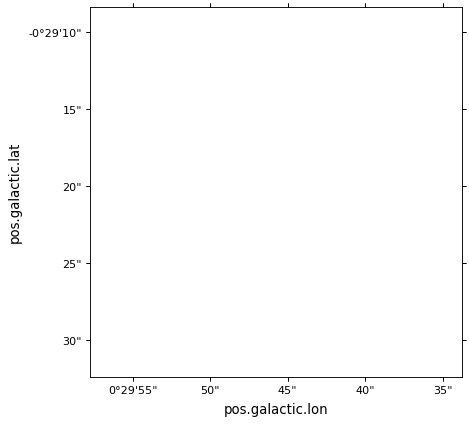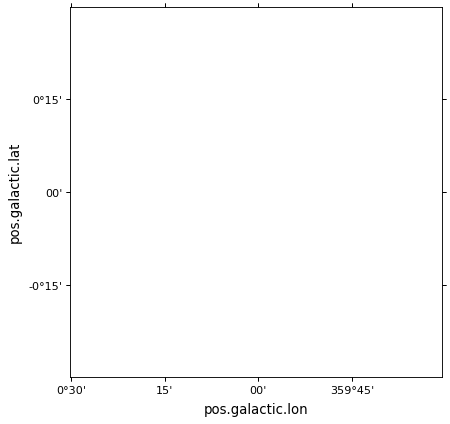Initializing axes with world coordinates¶
Basic initialization¶
To make a plot using WCSAxes, we first read in
the data using astropy.io.fits and parse the WCS
information. In this example, we will use an example FITS file from the
http://data.astropy.org server (the
get_pkg_data_filename() function downloads the file
and returns a filename):
from astropy.wcs import WCS
from astropy.io import fits
from astropy.utils.data import get_pkg_data_filename
filename = get_pkg_data_filename('galactic_center/gc_msx_e.fits')
hdu = fits.open(filename)[0]
wcs = WCS(hdu.header)
We then create a figure using Matplotlib and create the axes using the
WCS object created above. The following example shows how
to do this with the Matplotlib ‘pyplot’ interface, keeping a reference to the
axes object:
import matplotlib.pyplot as plt
ax = plt.subplot(projection=wcs)

The ax object created is an instance of the
WCSAxes class. Note that if no WCS
transformation is specified, the transformation will default to identity,
meaning that the world coordinates will match the pixel coordinates.
The field of view shown is, as for standard matplotlib axes, 0 to 1 in both directions, in pixel coordinates. As soon as you show an image (see Plotting images and contours), the limits will be adjusted, but if you want you can also adjust the limits manually. Adjusting the limits is done using the same functions/methods as for a normal Matplotlib plot:
ax.set_xlim(-0.5, hdu.data.shape[1] - 0.5)
ax.set_ylim(-0.5, hdu.data.shape[0] - 0.5)

Note
If you use the pyplot interface, you can also replace ax.set_xlim and
ax.set_ylim by plt.xlim and plt.ylim.
Alternative methods¶
As in Matplotlib, there are in fact several ways you can initialize the
WCSAxes.
As shown above, the simplest way is to make use of the WCS
class and pass this to plt.subplot. If you normally use the (partially)
object-oriented interface of Matplotlib, you can also do:
fig = plt.figure()
ax = fig.add_subplot(1, 1, 1, projection=wcs)
Note that this also works with add_axes() and
axes(), e.g.:
ax = fig.add_axes([0.1, 0.1, 0.8, 0.8], projection=wcs)
or:
plt.axes([0.1, 0.1, 0.8, 0.8], projection=wcs)
Any additional arguments passed to
add_subplot(),
add_axes(),
subplot(), or axes(), such
as slices or frame_class, will be passed on to the
WCSAxes class.
Directly initializing WCSAxes¶
As an alternative to the above methods of initializing
WCSAxes, you can also instantiate
WCSAxes directly and add it to the
figure:
from astropy.wcs import WCS
from astropy.visualization.wcsaxes import WCSAxes
import matplotlib.pyplot as plt
wcs = WCS(...)
fig = plt.figure()
ax = WCSAxes(fig, [0.1, 0.1, 0.8, 0.8], wcs=wcs)
fig.add_axes(ax) # note that the axes have to be explicitly added to the figure